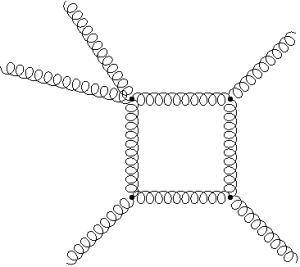Quantum field theory allows us to calculate “amplitudes” for particle scattering processes. These are mathematical functions that encode the probability of particles scattering through various angles. Although the theory is quite complicated, miraculously the rules for calculating these amplitudes are pretty easy!
The key idea came from physicist Richard Feynman. To calculate a scattering amplitude, you draw a series of diagrams. The vertices and edges of the diagram come with particular factors relevant to the theory. In particular vertices usually carry coupling constants, external edges carry polarization vectors, and internal edges carry functions of momenta.
From the diagrams you can write down a mathematical expression for the scattering amplitude. All seems to be pretty simple. But what exactly are the diagrams you have to draw?
Well there are simple rules governing that too. Say you want to compute a scattering amplitude with  incoming and
incoming and  outgoing particles. Then you draw four external lines, labelled with appropriate polarizations and momenta. Now you need to connect these lines up, so that they all become part of one diagram.
outgoing particles. Then you draw four external lines, labelled with appropriate polarizations and momenta. Now you need to connect these lines up, so that they all become part of one diagram.
This involves adding internal lines, which connect to the external ones at vertices. The types and numbers of lines allowed to connect to a vertex is prescribed by the theory. For example in pure QCD the only particles are gluons. You are allowed to connect either three or four different lines to each vertex.
Here’s a few different diagrams you are allowed to draw – they each give different contributions to the overall scattering amplitude. Try to draw some more yourself if you’re feeling curious!


Now it’s immediately obvious that there are infinitely many possible diagrams you could draw. Sounds like this is a problem, because adding up infinitely many things is hard! Thankfully, we can ignore a lot of the diagrams.
So why’s that? Well it transpires that each loop in the diagram contributes an extra factor of Planck’s constant  . This is a very small number, so the effect on the amplitude from diagrams with many loops is negligable. There are situations in which this analysis breaks down, but we won’t consider them here.
. This is a very small number, so the effect on the amplitude from diagrams with many loops is negligable. There are situations in which this analysis breaks down, but we won’t consider them here.
So we can get a good approximation to a scattering amplitude by evaluating diagrams with only a small number of loops. The simplest have  -loops, and are known as tree level diagrams because they look like trees. Here’s a QCD example from earlier
-loops, and are known as tree level diagrams because they look like trees. Here’s a QCD example from earlier

Next up you have  -loop diagrams. These are also known as quantum corrections because they give the QFT correction to scattering processes from quantum mechanics, which were traditionally evaluated using classical fields. Here’s a nice QCD
-loop diagrams. These are also known as quantum corrections because they give the QFT correction to scattering processes from quantum mechanics, which were traditionally evaluated using classical fields. Here’s a nice QCD  -loop diagram from earlier
-loop diagram from earlier

If you’ve been reading some of my recent posts, you’ll notice I’ve been talking about how to calculate tree level amplitudes. This is sensible because they give the most important contribution to the overall result. But the real reason for focussing on them is because the maths is quite easy.
Things get more complicated at  -loop level because Feynman’s rules tell us to integrate over the momentum in the loop. This introduces another curve-ball for us to deal with. In particular our arguments for the simple tree level recursion relations now fail. It seems that all the nice tricks I’ve been learning are dead in the water when it comes to quantum corrections.
-loop level because Feynman’s rules tell us to integrate over the momentum in the loop. This introduces another curve-ball for us to deal with. In particular our arguments for the simple tree level recursion relations now fail. It seems that all the nice tricks I’ve been learning are dead in the water when it comes to quantum corrections.
But thankfully, all is not lost! There’s a new set of tools that exploits the structure of  -loop diagrams. Back in the 1950s Richard Cutkosky noticed that the
-loop diagrams. Back in the 1950s Richard Cutkosky noticed that the  -loop diagrams can be split into tree level ones under certain circumstances. This means we can build up information about loop processes from simpler tree results. The underlying principle which made this possible is called unitarity.
-loop diagrams can be split into tree level ones under certain circumstances. This means we can build up information about loop processes from simpler tree results. The underlying principle which made this possible is called unitarity.
So what on earth is unitarity? To understand this we must return to the principles of quantum mechanics. In quantum theories we can’t say for definite what will happen. The best we can do is assign probabilities to different outcomes. Weird as this might sound, it’s how the universe seems to work at very small scales!
Probabilities measure the chances of different things happening. Obviously if you add up the chances of all possible outcomes you should get  . Let’s take an example. Suppose you’re planning a night out, deciding whether to go out or stay in. Thinking back over the past few weeks you can estimate the probability of each outcome. Perhaps you stay in
. Let’s take an example. Suppose you’re planning a night out, deciding whether to go out or stay in. Thinking back over the past few weeks you can estimate the probability of each outcome. Perhaps you stay in  times out of
times out of  and go out
and go out  times out of ten.
times out of ten.  just as we’d expect for probability!
just as we’d expect for probability!
Now unitarity is just a mathsy way of saying that probabilities add up to  . It probably sounds a bit stupid to make up a word for such a simple concept, but it’s a useful shorthand! It turns out that unitarity is exactly what we need to derive Cutkosky’s useful result. The method of splitting loop diagrams into tree level ones has become known as the unitarity method.
. It probably sounds a bit stupid to make up a word for such a simple concept, but it’s a useful shorthand! It turns out that unitarity is exactly what we need to derive Cutkosky’s useful result. The method of splitting loop diagrams into tree level ones has become known as the unitarity method.
The nicest feature of this method is that it’s easy to picture in terms of Feynman diagrams. Let’s plunge straight in and see what that looks like.

At first glance it’s not at all clear what this picture means. But it’s easy to explain step by step. Firstly observe that it’s an equation, just in image form. On the left hand side you see a loop diagram, accompanied by the word  . This indicates a certain technical property of a loop diagram that it’s useful to calculate. On the right you see two tree diagrams multiplied together.
. This indicates a certain technical property of a loop diagram that it’s useful to calculate. On the right you see two tree diagrams multiplied together.
Mathematically these diagrams represent formulae for scattering amplitudes. So all this diagram says is that some property of  -loop amplitudes is produced by multiplying together two tree level ones. This is extremely useful if you know about tree-level results but not about loops! Practically, people usually use this kind of equation to constrain the mathematical form of a
-loop amplitudes is produced by multiplying together two tree level ones. This is extremely useful if you know about tree-level results but not about loops! Practically, people usually use this kind of equation to constrain the mathematical form of a  -loop amplitude.
-loop amplitude.
If you’re particularly sharp-eyed you might notice something about the diagrams on the left and right sides of the equation. The two diagrams on the right come from cutting through the loop on the left in two places. This cutting rule enables us to define the unitarity method for all loop diagrams. This gives us the full result that Cutkosky originally found. He’s perhaps the most aptly named scientist of all time!
We’re approaching the end of our whirlwind tour of particle scattering. We’ve seen how Feynman diagrams give simple rules but difficult maths. We’ve mentioned the tree level tricks that keep calculations easy. And now we’ve observed that unitarity comes to our rescue at loop-level. But most of these ideas are actually quite old. There’s just time for a brief glimpse of a hot contemporary technique.
In our pictorial representation of the unitarity method, we gained information by cutting the loop in two places. It’s natural to ask whether you could make further such cuts, giving more constraints on the form of the scattering amplitude. It turns out that the answer is yes, so long as you allow the momentum in the loop to be a complex number!
You’d be forgiven for thinking that this is all a bit unphysical, but in the previous post we saw that using the complex numbers is actually a very natural and powerful mathematical trick. The results we get in the end are still real, but the quickest route there is via the complex domain.
So why do the complex numbers afford us the extra freedom to cut more lines? Well, the act of cutting a line is mathematically equivalent to taking the corresponding momentum  to be on-shell; that is to say
to be on-shell; that is to say  . We live in a four-dimensional world, so
. We live in a four-dimensional world, so  has four components. That means we can solve a maximum of four equations
has four components. That means we can solve a maximum of four equations  simultaneously. So generically we should be allow to cut four lines!
simultaneously. So generically we should be allow to cut four lines!
However, the equations  are quadratic. This means we are only guaranteed a solution if the momentum
are quadratic. This means we are only guaranteed a solution if the momentum  can be complex. So to use a four line cut, we must allow the loop momentum to be complex. With our simple
can be complex. So to use a four line cut, we must allow the loop momentum to be complex. With our simple  line cuts there was enough freedom left to keep
line cuts there was enough freedom left to keep  real.
real.
The procedure of using several loop cuts is known as the generalized unitarity method. It’s been around since the late 90s, but is still actively used to determine scattering amplitudes. Much of our current knowledge about QCD loop corrections is down to the power of generalized unitarity!
That’s all for now folks. I’ll be covering the mathematical detail in a series of posts over the next few days.
My thanks to Binosi et al. for their excellent program JaxoDraw which eased the drawing of Feynman diagrams.
super Yang-Mills (SYM). This sounds pretty pointless, at least at first. But actually this model shares many features with more complete accounts of reality. So it’s not all pie in the sky.
SYM.




